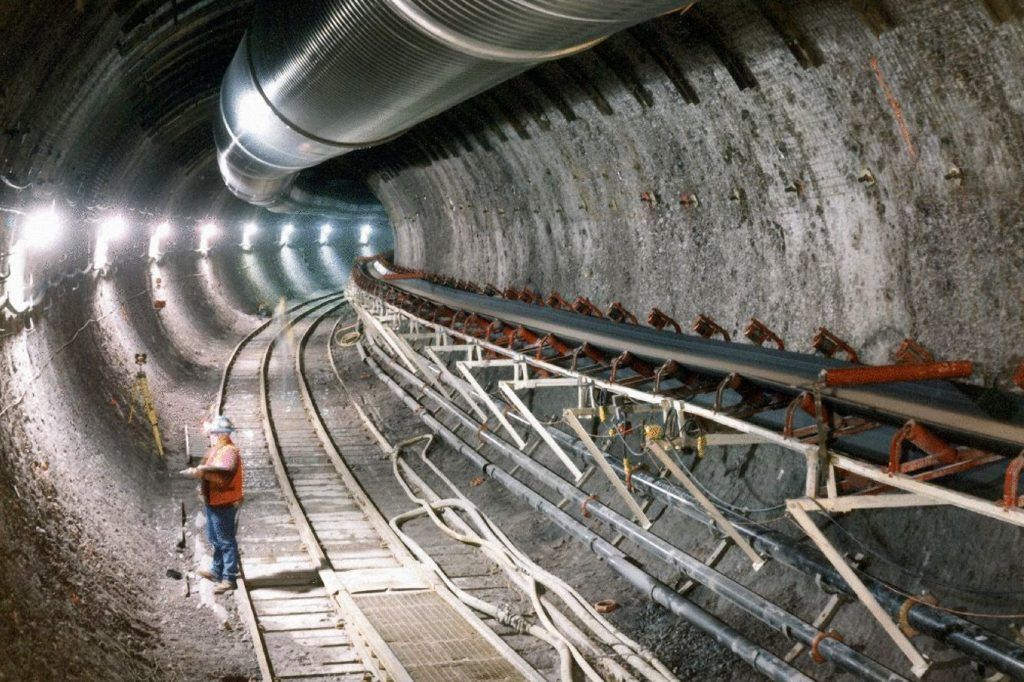Argonne scientists say they’ve developed a better way to deal with nuclear waste—thanks to 3-D printers
By John Krzyzaniak | October 25, 2019
 The underground Exploratory Studies Facility at Yucca Mountain in Nevada built by the Department of Energy to determine whether the location was suitable as a deep geological nuclear waste repository. Image credit: US Department of Energy.
The underground Exploratory Studies Facility at Yucca Mountain in Nevada built by the Department of Energy to determine whether the location was suitable as a deep geological nuclear waste repository. Image credit: US Department of Energy.
One of the major objections to nuclear energy has been the problem of radioactive nuclear waste. Although we have the capability to reprocess about 95 percent of the spent nuclear fuel from a reactor, the amount of highly radioactive waste that remains is nevertheless substantial. And that waste needs to be stored for hundreds of thousands of years before the toxic isotopes decay to a safe level.
Now, a team of scientists at Argonne National Laboratory claims to have a way to recycle an additional two percent of the nuclear waste at an industrial level using 3-D printed parts. The chemical procedure itself is not new—it was developed in 2013 by Artem V. Gelis, now director of the radiochemistry program at University of Las Vegas. What’s new is the ability to easily scale the process in a way that will be useful to the nuclear power industry, and that’s possible thanks to 3-D printing.
Two percent sounds like a trivial amount. However, according to Andrew Breshears, one of the authors of the study, the discovery is more consequential than it seems. Speaking with Phys.org, he said, “[r]ather than store five percent for hundreds of thousands of years, the remaining three percent needs to be stored at a maximum of about 1,000 years. In other words, this additional step may reduce the length of storage almost one thousandfold.”
While the discovery is impressive, the claims require some qualification. But first it’s necessary to know some basics about reprocessing.
A nuclear power plant employs nuclear fission to generate energy, but this generates waste in the form of spent fuel. The spent fuel contains both reusable material, such as plutonium and uranium, and non-reusable material, such as cesium and iodine. The basic goal of reprocessing is to separate out the reusable material so that it can be fed back into reactors as fuel. The current standard method for reprocessing—the one that reduces nuclear waste by about 95 percent—is called Plutonium and Uranium Recovery by Extraction, or PUREX.
The chemical process developed in 2013, called ALSEP (Actinide Lanthanide Separation Process), is an extra step that happens after the PUREX process is complete. ALSEP separates out two additional isotopes, americium and curium, from the rest of the waste. The americium and curium could be recycled as fuel in advanced fast neutron reactors, where they would break down into less radioactive isotopes, but such reactors are not yet commercially available. So for now, these isotopes would have to be stored as waste—forever—though if stored on their own they would take up less space in a disposal facility.
The remaining three percent of the original waste, divorced from its most highly radioactive material, would require significantly less storage time than if it hadn’t been reprocessed in this way, but still up to a thousand years.
Edwin Lyman, acting director of the Nuclear Safety Project at the Union of Concerned Scientists, raised several additional concerns. In an email to the Bulletin, he pointed out that there is no fleet of breeder reactors capable of burning reprocessed uranium, so the assertion that we can recycle 95 percent of spent fuel, let alone the additional two percent, is misleading. Further, he wrote that in order to have a huge effect in terms of conserving space in a long-term geologic disposal facility, other fission products such as cesium and strontium would also need to be separated out. Finally, he called the use of 3-D printers “a gimmick without any real significance for the study’s conclusions.”
In any event, the new process will not afford any immediate benefit in the United States, since US energy policy rejects reprocessing altogether for civilian nuclear waste. The US nuclear industry collectively generates about 2,000 tons of spent nuclear fuel every year, and the reactor owners store this nuclear waste on-site in dry casks.
Together, we make the world safer.
The Bulletin elevates expert voices above the noise. But as an independent nonprofit organization, our operations depend on the support of readers like you. Help us continue to deliver quality journalism that holds leaders accountable. Your support of our work at any level is important. In return, we promise our coverage will be understandable, influential, vigilant, solution-oriented, and fair-minded. Together we can make a difference.
Keywords: 3-D printing, Argonne, nuclear waste disposal, spent fuel reprocessing
Topics: Analysis, Nuclear Energy















It’s not waste, it’s partially spent fuel and fission products that need isolation for various times. When the partially spent fuel is finally used in the future the ultimate fission products need isolation for 300 years until they are stable Non-radioactive elements like lead, zirconium, barium, gold and platinum.
We’re not there yet. May I refer you to a Bulletin article from 2017
https://thebulletin.org/2017/04/fusion-reactors-not-what-theyre-cracked-up-to-be/
Edwin Lyman’s comments appear to be off the point. First- the 3D printers is not a gimmick here. They were used to make the multistage contactor bank for the process demonstration. This resulted in a significant decrease of the cost of the test equipment as well as in a decrease of the volumes of the radioactive test solutions ( total radionuclide inventory and the dose rate) used in the test. Without 3D printing the demonstration would unlikely to happen. Second– while Cs and Sr do contribute to the heat load of the nuclear waste repository, many studies indicate that the… Read more »